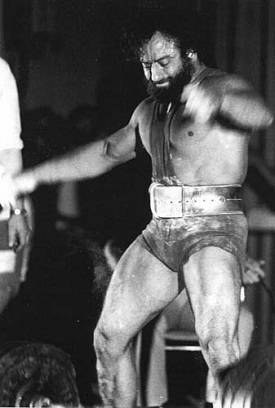I just finished my third day of driving, so don’t expect the great American novel. I’ve been listening to a lot of the Paleo Solution Podcast with Robb Wolf and Greg Everett. It’s a solid podcast, mostly because it’s probably kept me awake and not dead. While listening earlier, some random guy was writing in about belts. The guy asking the question cited something Rippetoe said about wearing flared belts backwards (Greg snickered) and then referenced ME. But he didn’t even reference me correctly, he took something I said out of context.
A long time ago when I still lived in Texas I noted on 70’s Big how I wore a velcro belt for the Olympic lifts (because the bar would hit my suede belt if I wore it), the suede belt on squat and press, and a thinner leather belt for deadlifts (because the suede belt pinched me when I was just a boy). Nowadays I just wear the suede belt on everything (including clean and jerk). I wasn’t recommending that everyone do the above, merely pointing out what I did at the time. Greg interrupted himself from reading the question and said pointedly, “Everyone on the internet is wrong.” I just stopped the podcast right there and said aloud to my dogs, “Can’t do it.”
It’s natural for me to get lumped in with Rippetoe considering I managed his gym for a year and half, but I haven’t been there in over two years so equating us would be inaccurate. But I’m more talking about my shame, man, my shame! I actually don’t know if I should be ashamed cause I didn’t finish listening.
Look, I don’t know what the hell I’m talking about. I’ve been driving for three days straight and I’m about to go to sleep; things aren’t coherent. I just wanted to add some information to the plethora of belt knowledge in the archives and it sounded like a good intro. We get new readers all the time, so covering old topics will never hurt.
1. Belts improve performance
Chris’ master’s thesis looked at comparing a belted and un-belted 1RM in trained lifters (guys who could squat at least 1.5 times body weight). Everyone, including the guy who had never worn a belt before, squatted more in their belted attempts in this blind study (i.e. they didn’t know what weight was on the bar). Even Brent squatted more, and he most likely aimed to do the opposite just to fuck with the study. The sample size was small (7 guys or so), yet it’s the only study that looks at the performance of the belt as opposed to the obvious pressure increased caused by wearing the belt. Which leads us to…
2. Belts increase pressure
I put this in here because the guy asking Robb/Greg the question wasn’t technically correct. The belt increases pressure in two ways. The first is that it decreases the volume of the trunk. If we assume the same big breath of air (same quantity) with the decreased volume, Boyle’s Law shows us that the pressure increases. The second is that the abdominals contract harder into the surface area of the belt. The result is an increase of pressure in a) the intraabdominal cavity and b) the intrathoracic cavity. These are two distinct areas and they both have a resultant pressure increase.
3. There’s a training effect from chronic belt use.
People always ask, “How much more weight should I be able to squat with a belt?” It doesn’t work like that; there isn’t a standardized amount that you can accomplish with and without a belt. And even if there was, it would be an individualized thing. If you accept that the abdominals contract harder (and this can be felt after the first few belted sessions — the abs are distinctly sore), then that means they are trained differently (i.e. more) when belted. After a given amount of time, say 8 weeks, the trainee will be stronger with a belt than they would have been without the belt. Since pretty much everyone squats more with a belt, that means the un-belted strength will also have increased more compared to if the trainee had never worn the belt in that 8 weeks.
4. Belts improve efficiency, safety.
The pressure increases in the torso act as a pneumatic brace against the anterior portion of the spine. This “air brace” helps stabilize and solidify the trunk, allowing for all of the force of the working muscles to be transferred into the bar. This extra stabilization also means that the trunk is safer than it would be if the belt were not being used. Remember: in lifting, safety = efficiency.
5. Inzer makes great belts.
I highly recommend Inzer belts for their great quality and durability. They were kind enough to send Chris several belts to use for his study.
6. You are not Russian.
There are a lot of assholes like Brent who think they don’t need a belt. Hey, if you’ve been lifting since you were nine years old and were given exemplary supplements, you’d be so jacked you wouldn’t need a belt. But you aren’t. You’re just some dude who picked up the sport recently. You are not a beautiful snowflake; you’re just some crusty piece of ice falling from Klokov’s frozen ball hair. Put the belt on. Or don’t, I don’t care.
To read more about belts and other gear, see this post.

